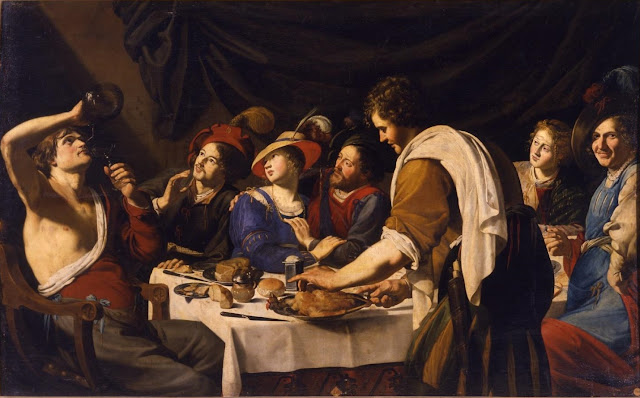 |
| Bartolomeo Manfredi Fortune Teller ca. 1616-17 oil on canvas Detroit Institute of Arts |
 |
| Bartolomeo Manfredi Cupid Chastised 1613 oil on canvas Art Institute of Chicago |
 |
| Bartolomeo Manfredi Banqueting Scene ca. 1610-20 oil on canvas Real Academia de Bellas Artes de San Fernando, Madrid |
"Bartolomeo Manfredi was first a pupil of Roncalli, but eventually became a follower of Caravaggio, loving the same subjects – as soldiers, banditti, gamesters, &c, and he generally painted only half figures. The works of Manfredi are accordingly very scarce, as he has had the too common fate of imitators; his best productions being ascribed to his caposcuola Caravaggio, or to his bold imitator Valentin de Boulogne."
– Ralph Nicholson Wornum, from The Epochs of Painting (London: Chapman & Hall, 1864)
 |
| Bartolomeo Manfredi Tavern Scene with Lute Player ca, 1621 oil on canvas Los Angeles County Museum of Art |
 |
| Bartolomeo Manfredi Peter's Denial of Christ before 1622 oil on canvas Herzog Anton Ulrich Museum, Braunschweig |
 |
| Bartolomeo Manfredi Taking of Christ ca. 1613-18 oil on canvas National Museum of Western Art, Tokyo |
 |
| Bartolomeo Manfredi Christ crowned with Thorns ca. 1610-20 oil on canvas Musée de Tessé, Le Mans |
 |
| Bartolomeo Manfredi Christ Blessing ca. 1610-20 oil on canvas private collection |
"According to Bellori, Manfredi 'transformed himself into another Caravaggio'; that is, in the power of his chiaroscuro and the warmth and luminosity of his colors he followed the example of Caravaggio as closely as any other Italian. In his rendering of costume, armor and other details he possessed a sensitivity reminiscent of the Netherlandish painters. On the other hand, he almost totally lacked the ability to conceive the monumental or the dramatic; he therefore limited himself to single half-length figures or to conversation pieces with knee-length figures that are quite static in concept and are accordingly composed without linear contrasts and deficient in piquancy. This is the essence of Baglione's criticism, which accuses the artist of having limited imagination and presents him as no more than a routine technician whose entire art consisted in the use of certain varnishes and binding media."
– Hermann Voss, from Baroque Painting in Rome (1925), revised and translated by Thomas Pelzel (San Francisco: Alan Wofsy, 1997)
 |
| Bartolomeo Manfredi St Peter and St Paul ca. 1610 oil on canvas Metropolitan Museum of Art, New York |
 |
| Bartolomeo Manfredi Triumph of David ca. 1615 oil on canvas Musée du Louvre |
 |
| Bartolomeo Manfredi Cain slaying Abel ca. 1610 oil on canvas Kunsthistorisches Museum, Vienna |
 |
| Bartolomeo Manfredi Allegory of the Four Seasons ca. 1610 oil on canvas Dayton Art Institute (Ohio) |
 |
| Bartolomeo Manfredi Apollo and Marsyas ca. 1615-20 oil on canvas St Louis Art Museum |
 |
| Bartolomeo Manfredi Lute Player ca. 1610 oil on canvas Hermitage, Saint Petersburg |